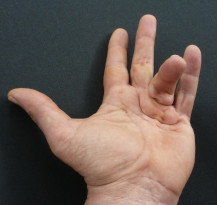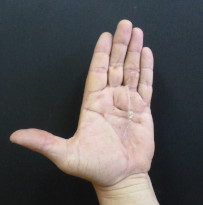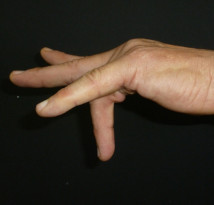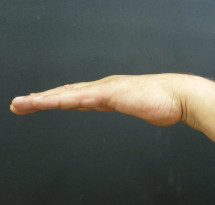

Hand Surgery
If your hand is impaired in any way, surgery may improve your condition. This type of very specialized surgery can treat diseases that cause pain and impair the strength, function and flexibility of your wrist and fingers. Surgery seeks to restore to near normal the function of fingers and hands injured by trauma or to correct abnormalities that were present at birth. Specifically, hand surgery can treat:
Carpal tunnel syndrome – a condition caused by pressure to the median nerve within the wrist, or carpal tunnel. You might feel pain, a tingling sensation, numbness of the fingers, weakness or aching. Carpal tunnel syndrome is associated with multiple conditions including: repetitive motion or overuse, fluid retention during pregnancy, injury to the nerve in the carpal tunnel or rheumatoid arthritis.
Rheumatoid arthritis – a disabling disease that can cause severe inflammation in any joint of the body. In the hand, it can deform fingers and impair movement.
Dupuytren’s contracture – a disabling hand disorder in which thick, scar-like tissue bands form within the palm and may extend into the fingers. It can cause restricted movement, bending the fingers into an abnormal position.
Is it right for me? – Hand surgery is a highly individualized procedure which can be performed on people of any age and is a good option for you if:
- You do not have additional medical conditions or other illnesses that may impair healing
- You are a non-smoker
- You have a positive outlook and realistic goals for your hand surgery
- You are committed to following your plastic surgeon’s prescribed course of treatment
- In some conditions, hand surgery is necessary to treat wounds and to help painful conditions
Before the operation
The success and safety of your hand procedure depends very much on your complete candidness during your hand surgery consultation. You’ll be asked a number of questions about your health, desires and lifestyle. Be prepared to discuss:
- Why you want the procedure, your expectations and desired outcome
- Medical conditions, drug allergies and medical treatments
- Use of current medications, vitamins, herbal supplements, alcohol, tobacco and drugs
- Previous surgeries
Your surgeon may also:
- Evaluate your general health status and any pre-existing health conditions or risk factors
- Examine your hand in detail
- Discuss your options and recommend a course of treatment to restore hand function
- Discuss likely outcomes of hand surgery and any risks or potential complications
Prior to hand surgery, you may be asked to:
- Get lab testing or a medical evaluation
- Take certain medications or adjust your current medications
- Stop smoking well in advance of surgery
- Avoid taking aspirin and certain anti-inflammatory drugs and herbal supplements as they can increase bleeding
Special instructions you receive will cover:
- What to do on the day of surgery
- The use of anaesthesia during your procedure
- Post-operative care and follow-up
Your plastic surgeon will also discuss where your procedure will be performed. If your hand surgery is performed on an outpatient basis, be sure to arrange for someone to drive you to and from surgery and to stay with you for at least the first night following surgery.
Hospital stay and type of anesthesia
Medications are administered for your comfort during the surgical procedures. The choices include intravenous sedation and general anaesthesia. Your doctor will recommend the best choice for you.
Hospital stay depends on the procedure. The patient may leave on the same day after some hours of medical supervision, or a short hospital stay can be preferable.
The procedure
Step 1 – The incision
Treating trauma
The most common traumatic hand or finger injury requiring hand surgery is tendon repair. When a tendon is cut, it will retract from the original wound site. Tendon repair retrieves the retracted tendon and reconnects it using surgical techniques to restore function and movement.
Carpal tunnel syndrome relief
Pressure on the median nerve in the carpal tunnel must be relieved to repair this condition. An incision is made from the middle of the palm to the wrist, allowing access to the constricted tissue causing pressure on the nerve. An alternate procedure is referred to as an endoscopic carpal tunnel release, with smaller incisions (see blue dotted lines) and the use of a surgical microscope or endoscope, a small flexible tube that contains a light and lens, to release pressure.
Birth deformities can be repaired
When fingers are fused together at birth, called syndactyly, they may be joined only by a web of skin or by skin and a partial fusion of bones. Surgery involves separating the two fingers to provide a full range of motion and a normal appearance, as well as permitting more normal finger growth. Techniques such as skin grafting or a local flap procedure like Z-plasty create flexibility at the incision site for growth and movement of the fingers.
Your plastic surgeon may recommend one or a combination of techniques to achieve your goals. Some of those techniques include: microsurgery, grafting of skin, bone, nerves or other tissue from healthy parts of the body, z-plasty and physical therapy.
Step 2 – Closing the incisions
Depending on your condition and type of treatment you may have incisions that need to be closed with removable sutures or your plastic surgeon may use non-removable sutures.
Step 3 – See the results
The results of hand surgery will appear gradually as swelling subsides. Your final outcome may not be realized for several months.
After the operation
After surgery, bandages or dressings may be applied to keep the surgical site clean and splints may be used when needed.
You will be given specific instructions that may include: How to care for your hand(s) following surgery, medications to apply or take orally to aid healing and reduce the risk of infection, and when to follow-up with your plastic surgeon.
Be sure to ask your plastic surgeon specific questions about what you can expect during your individual recovery period.
- Where will I be taken after my surgery is complete?
- What medication will I be given or prescribed after surgery?
- Will I have dressings/bandages after surgery? When will they be removed?
- Are stitches removed? When?
- When can I resume normal activity and exercise?
- When do I return for follow-up care?
Follow all postoperative instructions including cleansing, taking prescribed medications and hand therapy exercises. Therapy is critical to restoring strength, flexibility and movement. If you attempt to return to normal function too soon, the risk of re-injury is possible. Continue your hand therapy regimen and attend follow-up visits with your plastic surgeon as scheduled. This is essential to a successful outcome.
The end result of your hand surgery is directly related to following your therapist’s and plastic surgeon’s instructions.
Picture Gallery




The result
The final outcome of your hand surgery will develop over time. While advances in hand surgery can accomplish near miracles in reconstruction and replantation, your outcome cannot be fully predicted.
If you had surgery to correct carpal tunnel syndrome, modifying work habits as recommended is vital to long-term improvement. Your final outcome may not be realized for several months. If your procedure involved microsurgery, a year is considered appropriate to fully reach restored function.
Imperfect results
The decision to have hand surgery is extremely personal and you’ll have to decide if the benefits will achieve your goals and if the risks and potential complications are acceptable. Your plastic surgeon and/or staff will explain in detail the risks associated with surgery.
You will be asked to sign consent forms to ensure that you fully understand the procedure you will undergo, the alternatives and the most likely risks and potential complications from hand surgery.
Possible complications
Hand surgery is a surgical procedure, with the consequent risks related to all medical acts. There are surgical and aesthetic complications. Concerning anesthesia, the anesthesiologist will inform you about all the anesthetic risks. You must be aware that anesthesia can sometimes cause unpredictable body reactions that can be difficult to control. The presence of an experienced anesthesiologist, in a surgical environment, means that the risks are statistically practically negligible.
Some of the risks of hand surgery include:
- Bleeding (hematoma)
- Blood clots
- Infection
- Anaesthesia risks
- Unfavourable scarring
- Change in skin sensation
- Skin contour irregularities
- Skin discoloration/swelling
- Poor healing of incisions
- Unexpected hand swelling
- Allergies to tape, suture materials and glues, blood products, topical preparations or injected agents
- Deep vein thrombosis, cardiac and pulmonary complications
- Damage to deeper structures—such as nerves, blood vessels, muscles, and lungs—can occur and may be temporary or permanent
- Pain, which may persist
- Possibility of revisional surgery
Be sure to ask questions: It’s very important to ask your plastic surgeon questions about your procedure. It’s natural to feel some anxiety, whether it’s excitement for your anticipated new look or a bit of preoperative stress. Don’t be shy about discussing these feelings with your plastic surgeon.
Additional risks associated with these specific surgeries include:
Carpal tunnel
- Non-improvement
- Recurrence of carpal tunnel syndrome
Extensor tendon
- Additional incisions necessary because cut tendons may retract
- Failure of tendon repair
- Inability to restore function
- Tendon scarring
Flexor tendon
- Additional incisions necessary because cut tendons may retract
- Inability to restore function
- Tendon scarring
Tenolysis
- Abnormal tendon position
- Additional incisions necessary where scarring occurs or to make new incisions to release scar tissue that is limiting tendon motion
- Inability to restore function
- Recurrent tendon scarring
- Rupture of tendon
- Seroma (fluid accumulation)
- Wound breakdown
Trigger finger
- Non-improvement
- Tendon scarring
My Way …. “Metron Ariston”
Having been extensively specialized in Microsurgery (Postgraduate Degree in Experimental Surgery and Microsurgery from the University of Paris VII, France & Postgraduate Degree in Plastic Surgery and Microsurgery from the University of Nancy I, France), I can apply highly sophisticated techniques to repair and/or reconnect severed nerves and tendons, common in trauma cases, or to reattach severed fingers or limbs.
In cases of soft tissue coverage, I apply an individualized to each case approach of reconstructive procedures and techniques to ensure the ideal soft tissue coverage. These include skin grafts, local flaps, distant flaps, and micro-vascular free tissue transfer. Selecting the most suitable type of soft tissue coverage for a particular defect relies on the particularities of each case with the aim to restore the full functionality of the hand.
This webpage aims to provide some information about the subject. Individual patient circumstances may differ, which might alter both the advice and course of therapy given to you by your doctor.
Source:
American Society of Plastic Surgeons, British Association of Plastic, Reconstructive and Aesthetic Surgeons, French Society of Plastic, Reconstructive and Aesthetic Surgery
